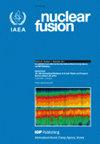Electron cyclotron current start-up using a retarding electric field in the QUEST spherical tokamak
IF 4
1区 物理与天体物理
Q1 PHYSICS, FLUIDS & PLASMAS
引用次数: 0
Abstract
The plasma current start-up experiment is conducted through electron cyclotron (EC) heating in the QUEST spherical tokamak. During the EC heating, the application of a toroidal electric field in the opposite direction to the plasma current effectively inhibits the growth of energetic electrons. Observations show rapid increases in plasma current and hard x-ray count immediately following the cancellation of the retarding electric field. When a compact tokamak configuration maintains equilibrium on the high field side, along with the retarding field, it leads to effective bulk electron heating. This heating achieved an electron temperature of在 QUEST 球形托卡马克中利用迟滞电场启动电子回旋加速器电流
等离子体电流启动实验是通过 QUEST 球形托卡马克中的电子回旋加速器(EC)加热进行的。在电子回旋加速器加热过程中,施加与等离子体电流方向相反的环形电场可有效抑制高能电子的增长。观测结果表明,等离子体电流和硬 X 射线计数在抑制电场取消后立即迅速增加。当紧凑型托卡马克结构在高电场一侧与阻滞电场保持平衡时,会导致有效的电子体加热。在电子密度为 ne > 1.0 × 1018 m-3 的情况下,这种加热使电子温度达到 Te ≈ 1 keV。对电离层波的射线追踪证实,在电子密度和温度值较高的第二共振层周围,通过单程吸收进入等离子体的功率更大。
本文章由计算机程序翻译,如有差异,请以英文原文为准。
求助全文
约1分钟内获得全文
求助全文
来源期刊

Nuclear Fusion
物理-物理:核物理
CiteScore
6.30
自引率
39.40%
发文量
411
审稿时长
2.6 months
期刊介绍:
Nuclear Fusion publishes articles making significant advances to the field of controlled thermonuclear fusion. The journal scope includes:
-the production, heating and confinement of high temperature plasmas;
-the physical properties of such plasmas;
-the experimental or theoretical methods of exploring or explaining them;
-fusion reactor physics;
-reactor concepts; and
-fusion technologies.
The journal has a dedicated Associate Editor for inertial confinement fusion.
 求助内容:
求助内容: 应助结果提醒方式:
应助结果提醒方式:


